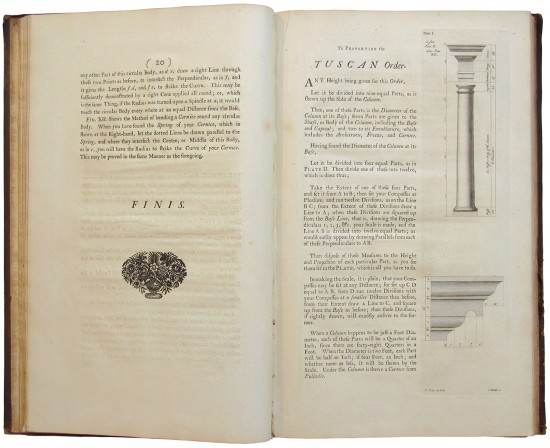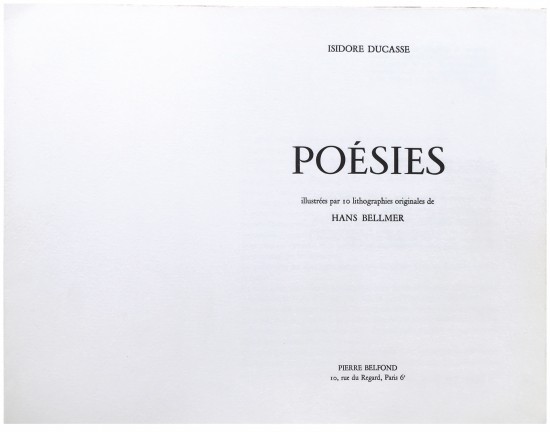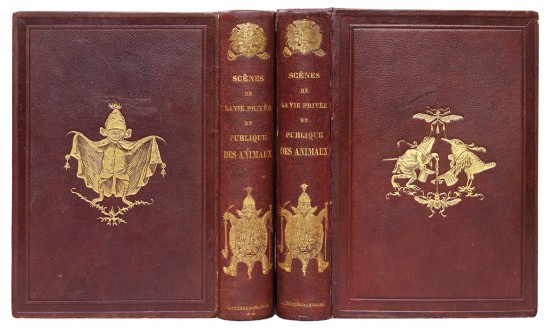Le Pitture Antiche del Sepolcro de' Nasonii nella Via Flaminia. Disegnate, ed intagliate alla similitudine degli Antichi Originali da Pietro Santi Bartoli
Bartoli. Bellori, Giovanni Pietro
Rome. Antonio de Rossi. 1702
Second edition of Bartoli's important study of the frescoes of the tomb of Quintus Nasonius Ambrosius.
One of the most important archaeological finds of the period, the tomb of Quintus Nasonius Ambrosius was originally unearthed in March 1674 during the course of excavations of the Via Flaminia. Regarded as one of the most elaborate examples of sepulchral art from the Roman era, painted around 150 AD, its discovery occasioned much excitement, not least because at first it was widely believed to be the tomb of the poet Ovid. The tomb was a family burial place with multiple niches, adorned by frescoes with a series of seven apse paintings, a figured frieze incorporating ten enigmatic mythological figures, and a cassette ceiling.The walls contain scenes referring to death and the underworld, while the ceiling alludes to the soul's liberation after death.
Pietro Santi Bartoli (1635-1700), the engraver and draughtsman, was probably engaged by Cardinal Camillo Massimo to produce a record of the frescoes adorning the walls of the tomb. Bartoli was responsible for several publications on Roman sculpture and works of art, such as the 'Admiranda romanarum antiquitatum' of 1693. In 1680, he produced these engravings of the Nasonii tomb paintings, and the work includes a commentary by Bartoli's friend, Giovanni Pietro Bellori (1613-96), the leading theorist of seventeenth century classicism. The work appears to have been so successful that not only was this second edition published in 1702, but the work was also republished as part of a larger work, 'Le pitture antiche delle grotte di Roma, e del sepolcro de' Nasonii' (Rome. Zenobi, 1706), combined in one volume with two other illustrated essays, 'Pitture antiche delle grotte' (begun by Pietro Santi Bartoli and completed by his son Francesco), and 'Appendice di alcune memorie sepolcrali, e di varia cose appartenenti a' defonti'.
One of the most important archaeological finds of the period, the tomb of Quintus Nasonius Ambrosius was originally unearthed in March 1674 during the course of excavations of the Via Flaminia. Regarded as one of the most elaborate examples of sepulchral art from the Roman era, painted around 150 AD, its discovery occasioned much excitement, not least because at first it was widely believed to be the tomb of the poet Ovid. The tomb was a family burial place with multiple niches, adorned by frescoes with a series of seven apse paintings, a figured frieze incorporating ten enigmatic mythological figures, and a cassette ceiling.The walls contain scenes referring to death and the underworld, while the ceiling alludes to the soul's liberation after death.
Pietro Santi Bartoli (1635-1700), the engraver and draughtsman, was probably engaged by Cardinal Camillo Massimo to produce a record of the frescoes adorning the walls of the tomb. Bartoli was responsible for several publications on Roman sculpture and works of art, such as the 'Admiranda romanarum antiquitatum' of 1693. In 1680, he produced these engravings of the Nasonii tomb paintings, and the work includes a commentary by Bartoli's friend, Giovanni Pietro Bellori (1613-96), the leading theorist of seventeenth century classicism. The work appears to have been so successful that not only was this second edition published in 1702, but the work was also republished as part of a larger work, 'Le pitture antiche delle grotte di Roma, e del sepolcro de' Nasonii' (Rome. Zenobi, 1706), combined in one volume with two other illustrated essays, 'Pitture antiche delle grotte' (begun by Pietro Santi Bartoli and completed by his son Francesco), and 'Appendice di alcune memorie sepolcrali, e di varia cose appartenenti a' defonti'.
Irregular pagination: 1-16, 35-50, 65-76. 4to. (325 x 230 mm). Illustrated with 35 engraved plates, one folding. Contemporary full mottled calf, red leather title label on banded spine, gilt armorial vignette to front and rear boards.
#21602










